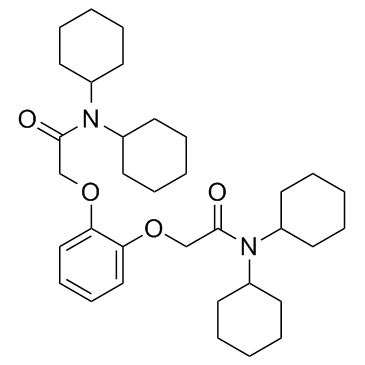All AbMole products are for research use only, cannot be used for human consumption.

Preincubation of the cells with the Na+ ionophore sodium ionophore III not only stimulated caffeate reduction, but completely abolished ATP synthesis. Addition of sodium ionophore III to cells in the steady state of caffeate reduction immediately dissipated the intracellular ATP level. Lactate-sulfate grown cells are insensitive to the Na+ ionophore, ETH2120. Sodium ionophore III ligand is a very effective receptor for the Eu3+ and Am3+ cations and can be considered as a potential extraction agent for nuclear iste treatment.
| Cell Experiment | |
|---|---|
| Cell lines | Desulfovibrio alaskensis |
| Preparation method | The protonophore 3,3,4,5-tetrachlorosalicylanilide (TCS, 5 µM or 20 µM), or the sodium-specific ionophore N,N,N′,N′-Tetracyclohexyl-1,2-phenylenedioxydiacetamide (ETH2120, 20 µM) were added to media to test their effects on growth. |
| Concentrations | 20 µM |
| Incubation time | 24 h |
| Animal Experiment | |
|---|---|
| Animal models | |
| Formulation | |
| Dosages | |
| Administration | |
| Molecular Weight | 552.79 |
| Formula | C34H52N2O4 |
| CAS Number | 81686-22-8 |
| Solubility (25°C) | 10 mM in DMSO |
| Storage |
Powder -20°C 3 years ; 4°C 2 years In solvent -80°C 6 months ; -20°C 1 month |
[2] Wang L, et al. PeerJ. The role of Rnf in ion gradient formation in Desulfovibrio alaskensis.
| Related Sodium Channel Products |
|---|
| 5-(N,N-Hexamethylene)-amiloride
5-(N,N-Hexamethylene)-amiloride (Hexamethylene amiloride) is a potent Na+/H+ exchanger inhibitor, which decreases the intracellular pH (pHi) and induces apoptosis in leukemic cells. 5-(N,N-Hexamethylene)-amiloride (Hexamethylene amiloride) is also an inhibitor of the HIV-1 Vpu virus ion channel and inhibits mouse hepatitis virus (MHV) replication and human coronavirus 229E (HCoV229E) replication in cultured L929 cells with EC50s of 3.91 μM and 1.34 μM, respectively. |
| HwTx-IV
Huwentoxin-IV (HwTx-IV) is a 35-residue neurotoxin peptide with potential application as a novel analgesic. Huwentoxin-IV, a component of tarantula venom, potently blocks sodium channels and is an attractive scaffold for engineering a Nav1.7-selective molecule. |
| ST-2560
ST-2560 is a selective inhibitor of the NaV1.7 sodium channel with IC50 value of 39 nM in primates with ≥1000-fold selectivity over other isoforms of the human NaV1.x family. |
| A-317567
A-317567 is a potent acid-sensing ion channel 3 (ASIC-3) inhibitor with an IC50 of 1.025 μM. |
| XPC-6444
XPC-6444 is a highly potent, isoform-selective, and CNS-penetrant NaV1.6 inhibitor (IC50=41 nM for hNaV1.6). |
All AbMole products are for research use only, cannot be used for human consumption or veterinary use. We do not provide products or services to individuals. Please comply with the intended use and do not use AbMole products for any other purpose.


Products are for research use only. Not for human use. We do not sell to patients.
© Copyright 2010-2024 AbMole BioScience. All Rights Reserved.
